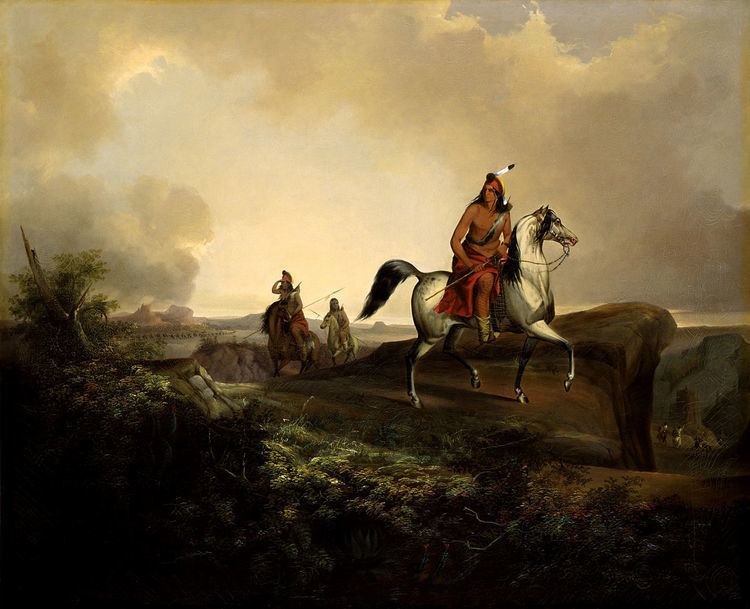Died 1850 or 1857 (?) Name Baishan Baishan | ||
 | ||
Nickname(s) Black Knife, Cuchillo Negro, Knife Similar People Mangas Coloradas, Victorio, Juh, Cochise, Geronimo | ||
Baishan, Spanish name Cuchillo Negro (Black Knife) (c. 1796 – May 24, 1857), was a Tchihende (Mimbres) Apache chieftain, of the Warm Springs Apache Band during the 1830s to 1850s.
Contents
Apache war-leader and chief
Baishan (“Knife”), son of the famed chief Fuerte aka Soldato Fiero, was a most respected war leader among the Tchihende bands along almost three decades from the beginning of 1830s, and the principal chief the Warm Springs local group of the Tchihende ("Chihenne") Apaches after Fuerte's death in 1837 near Janos; he was also the second principal chief of the whole Tchihende (or Mimbreño) Apaches after his long-time companion (and possibly brother-in-law) Mangas Coloradas, chief of the Coppermine local group of the same Tchihende (or "Chihenne") Apaches. His name was translated by the Mexicans as Cuchillo (“Knife”) or - because of the Apache practice of blackening their weapons to make them less conspicuous - as Cuchillo Negro (“Black Knife”). About 1835 (or 1837), Fuerte, chief of the Warmspring Mimbreño Apache, was killed near Santa Rita del Cobre by Mexican troops belonging to the garrison of Janos, but Juan José Compa, the old and Mexican friendly leader of the Coppermine Mimbreño Apaches, rejected Cuchillo Negro's request of help to assault and destroy Santa Rita; Cuchillo Negro led a bloody raid to Sonora. After Juan José Compa too was killed for bounty money in 1837 in the massacre at Santa Rita del Cobre, Cuchillo Negro joined Mangas Coloradas in his revenge, the two chiefs operating a series of retaliatory raids against the Mexicans, killing and destroying all around the mining town and placing Santa Rita under siege, finally attacking the column of fleeing Mexicans and slaughtering a large number. In 1844 Cuchillo Negro was claimed to have been killed by Mexican Troops in the Oputo Mountains. In 1847, to revenge the Galeana massacre, Cuchillo Negro called a council with the Tchihende (Mimbreño), Tsokanende (Chiricahua) and Ndendahe (Mogollon) chiefs: late in that autumn Mangas Coloradas, Cuchillo Negro and, probably, the Tsokanende leaders Miguel Narbona, Tapilà and Yrigollen went to raid Chihuahua with 200 warriors, occupying Ramos, near Janos, and killing most of the inhabitants. In 1848 Mangas Coloradas and Cuchillo Negro with their Mimbreños and Miguel Narbona and Yrigollen with their Chiricahuas attacked Sonora, and, on february 18th, they burned Chinapa killing or capturing many Mexicans. Cuchillo Negro's name is mentioned in military and civilian records of treaties and other dealings with Apaches during the early years of U.S. jurisdiction over the New Mexico Territory. In 1851 the settlement at Santa Rita del Cobre of the U.S. delegation (with gen. J.R. Bartlett) in the Mexican-American border Commission and the reopening of the Santa Rita del Cobre copper mines effected the meeting with the anglo-american newcomers, and Cuchillo Negro, just as Mangas Coloradas, Delgadito, Ponce, Coleto Amarillo and all the most important Tchihende and Ndendahe chiefs, had to face new problems; in June 1851 Mangas Coloradas, with Delgadito, Ponce and Coleto Amarillo, went to Santa Rita del Cobre to meet gen. J.R. Bartlett, U.S. commissioner appointed by Washinhgton in the U.S.-Mexican border Commission, and the attendance went on until the Apaches didn’t feel themselves disappointed and betrayed by the Anglo-american newcomers; Cuchillo Negro too had to face some problems in order to some young Mexican boys adopted in his band. In 1853, along with Ponce, Delgadito and Victorio, he signed a treaty in Fort Webster with indian agent Edward H. Wingfield sent by governor William Carr Lane.
Death
The U. S. Army claims Cuchillo Negro was killed in the Black Range by Pueblo scouts, under Col. William W. Loring, during the Bonneville Expedition in 1857 (May 25th, Canyon de los Muertos Carneros). However, the Fort Sill Apache, Chiricahua - Warm Springs Mimbreño Apache website erroneusly says he "Died in the revenge raid on Ramos (1850)." Famed Nana (Kas-tziden, "Brooken Foot") was his natural heir as chief of the Warm Spring Tchihende, but young Victorio's rising star overtook him since the early years 1860'.
Legacy
Several geological features in Sierra County, New Mexico bear his name: Cuchillo Negro Mountains, Cuchillo Negro Creek, and the town of Cuchillo, New Mexico.
A painting of Cuchillo Negro on horseback was done by John Mix Stanley in 1846. The painting hangs in the Smithsonian American Art Museum. It measures 42 1/2 x 52 in. (107.8 x 132.1 cm). Since Apaches traditionally did not wear feathers in this way there is some doubt the artist ever saw his subject.
"Black Knife" appears as a character in a 2011 science fiction film, Cowboys & Aliens.
